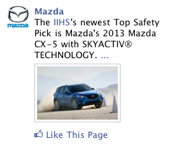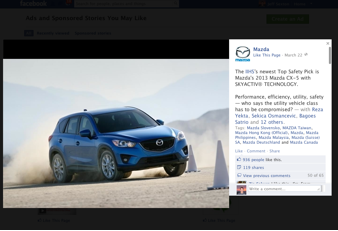“Plan the sale when you plan the ad” — Leo Burnett
First, I should say that I DO believe that Facebook ads can have a branding effects simply from exposure — that the unclicked ads can still prove valuable in influencing “share of mind.” Of course, this works much better for known brands, by the way, which makes Facebook Advertising a much better conjunction (rather than replacement) for traditional mass media ads.
But even if you’re hoping that ad exposure/impressions alone will influence Facebook users, that hardly means that you shouldn’t have a plan for further engaging and influencing your audience if and when they actually click on your ad.
Why in the world would you throw a prospects very valuable interest and attention away with a crappy post-click experience?
Well, that’s exactly what happened with this Mazda ad. Take a look:
 Here’s the ad trumpeting how the Mazda CX-5 was the Insurance Institute of Highway Safety’s Top Safety Pick. Cool.
Here’s the ad trumpeting how the Mazda CX-5 was the Insurance Institute of Highway Safety’s Top Safety Pick. Cool.
Mazda is a well known brand, and merely having people see this ad will help them think well — or at least thing better — about the brand.
But wouldn’t you guess that at least some viewers of this ad might like to learn more about the safety performance or features of the CX-5?
Wouldn’t you guess that at least some people might actually click the ad?
Well, here’s what those people get to see when that happens: 
A bigger picture, a repetition of the ad copy, and some additional marketing puffery.
That’s it.
Where’s a quote from the IIHS about the CX-5? Where’s the actual info on the CX-5s safety features? Where can I go to learn more? I mean, they don’t even provide a link to more info.
Just for reference, here’s a quick blurb I pulled together from a Mazda press release:
The all-new 2013 Mazda CX-5 received the Insurance Institute for Highway Safety’s (IIHS) highest possible crash safety rating in all four tests conducted: front, side and rear impact crash tests as well as a roof strength test (implemented in 2010), which measures occupant protection in the event of a rollover.
“The 2013 CX-5 is Mazda’s first production vehicle to receive the full suite of SKYACTIV® technologies, which focuses not only on fuel efficiency but also on safety and stability,” said Jim O’Sullivan, president and CEO, Mazda North American Operations (MNAO).
All CX-5s are equipped with the all-new SKYACTIV-Body which is comprised of 61 percent high-tensile steel, creating a lighter, stronger body with superior handling and ability to absorb impact. The all-new CX-5 also is the first production vehicle to utilize 1,800MPa ultra-high tensile steel, which are utilized in the front and rear bumper beams and results in parts that are 20 percent stronger and 10.6 pounds lighter than previous generation bumpers.
Other standard safety equipment includes six airbags (front, side and full side-curtain), four wheel disk brakes, anti-lock brakes (ABS), daytime running lights (DRL), Dynamic Stability Control (DSC), a Traction Control System (TCS), a fold-away brake pedal assembly, front and rear crumple zones, three-point safety belts for all seating positions, front seatbelt pretensioners, Lower Anchors and Tethers for Children (LATCH) and a tire pressure monitoring system (TPMS).
What would be so hard about providing that information on the click through? They already have it available in press releases and Websites. This isn’t about wasting the cost of the click, it’s about throwing away a prospective customers attention and interest, not just now, but later as well, because after this disappointing post-click experience, how much less likely is that prospect ever to click through again?
This ad has basically trained the interested prospect not to click on Mazda ads.
Don’t you make that mistake with your Facebook Ads.
—
Rob Lenderman is the Co-Founder of BoostCTR, a marketplace for copywriters. You can find him on Twitter @BoostCTR or at www.BoostCTR.com/blog



